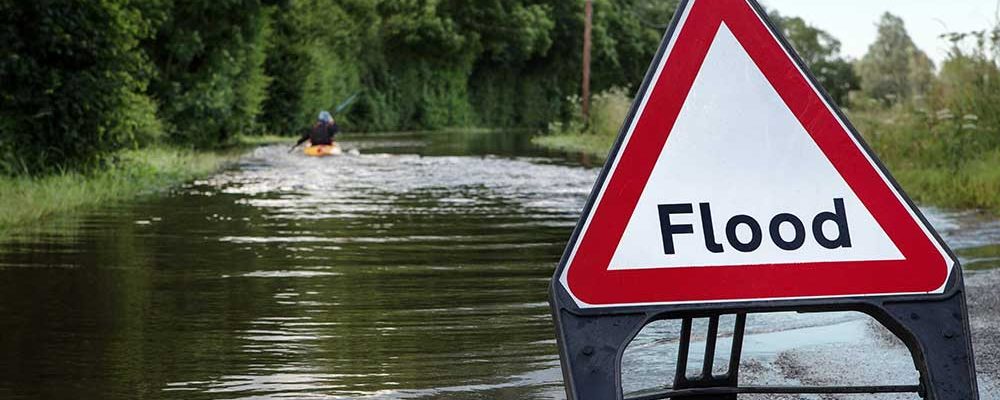It’s Sunday night and I’m drifting off to sleep when an almighty crash brings me back to my senses, the loudest thunderstorm I think I have ever heard is battering the neighbourhood. My chance of getting back to sleep is now further hampered by the concern that the torrential rain, given the extended period of dry weather causing my garden to harden to the consistency of rock, will cause flooding issues. Luckily, this time, we didn’t suffer any problems from the sudden and unusually heavy rain but unfortunately we have in the past. When we bought our house we checked, as most do, with the Environment Agency to see if there was any risk of flood but that was before we truly appreciated the risks posed by surface water flooding. It is now possible to check if your home or business is at risk. In 2008 the first map of areas at higher risk from surface water flooding was produced and in 2013 the government produced the Risk of Flooding from Surface Water maps. Check out whether your own house is at risk online at https://www.gov.uk/check-long-term-flood-risk.
Surprisingly, of all the flood risks our green and pleasant island suffers, it is surface water flooding rather than any river, watercourse or coastline that threatens people and properties the most, in particular businesses. According to the FloodFlash Commercial Risk Report 2021, 26% of commercial properties are at risk of flooding, compared to 14% of all properties in the UK.
Surface water flooding happens when it rains so hard the drains can’t cope, and if the ground is already saturated by previous rainfall or if it has been baked hard by the sun, the sudden deluge sits or flows on the surface rather than soaking away into the ground. It can often affect floodplains, dry lakes, and natural depressions in the land, basically anywhere that surface water can build up quickly and not drain away fast enough.
The level of risk depends on the capacity of the drainage systems and the permeability of the ground. Surface water flooding can be more prevalent in urban areas where man-made non-porous surfaces like concrete and tarmac are more common and where drainage systems may be easily overwhelmed or insufficient. The risk therefore tends to fall particularly on communities least able to afford it, for example poor urban areas with high density housing and extensive paved areas are less able to absorb the rainwater as big suburban gardens do.
The underlying problem with surface water flooding is that people don’t initially realise the risk. If you have not chosen to live near a river or the sea, it’s not entirely absurd to believe that you are free from the risk of flooding. In fact over 3 million properties in England are at risk of surface water flooding, even more than those at risk from rivers and the sea (2.7 million). However, surface water flooding poses much more of a risk to the overall infrastructure because of its reach and the subsequent consequences.
Has flooding increased in the UK as a whole though? Well, in short yes…from the start of the observational record in 1862, six of the ten wettest years across the UK have occurred since 1998. Climate change is increasing the risk of both flooding and drought in the UK. As the atmosphere warms, it can hold more water, which is then released as rain. Additionally a drought may end with heavy rainfall that does not drain away easily as the ground has dried out and so flooding may occur as a result. These conditions can also increase the chance of flash flooding, which is the rapid flooding of low-lying areas, usually occurring over a short period of time and associated with heavy rainfall from severe thunderstorms, hurricanes, and meltwater.
Overall, the UK is expected to experience wetter winters and drier summers. The more frequent and extreme rainfall that climate change brings will make flash flooding and overloading of the sewer network more commonplace, as experienced with a series of severe floods in recent years. In response to this flood forecasting has thankfully improved. In 2009 the Environment Agency and Met Office jointly established the Flood Forecasting Centre, providing a 24/7 flood forecasting service to the Environment Agency, the Government and the emergency responders.
Most important of all, surface water flooding is a growing risk. Summer rain will likely become more intense than currently experienced, in fact the chances of a detrimental heavy downpour are expected to increase by around 25%. Additionally an increasing urban population equates to further development, which means fewer places for rainwater to safely drain away. Unfortunately, the Climate Change Committee and other experts consider that progress in improving resilience to flooding in the UK is not keeping pace with the rising risk.
Specialist insurance for properties at risk of flood offers security to many households and businesses across the UK, these companies pay out almost £13 million per day to customers worst affected. So it is crucial that the industry understands current and future risks surrounding flooding, climate change and developments in construction and adapts quickly to respond to our changing landscape.
At E&G we make it a priority to stay up to date with this ever fluctuating environment and how this translates to the insurance market. Insurers’ approach to flooding varies a lot and knowing which one to approach for a particular property requires expertise and experience, which is exactly where we can help. We will compare prices across our panel of specialist insurers in order to get the best policy at the best price for you and your home.

